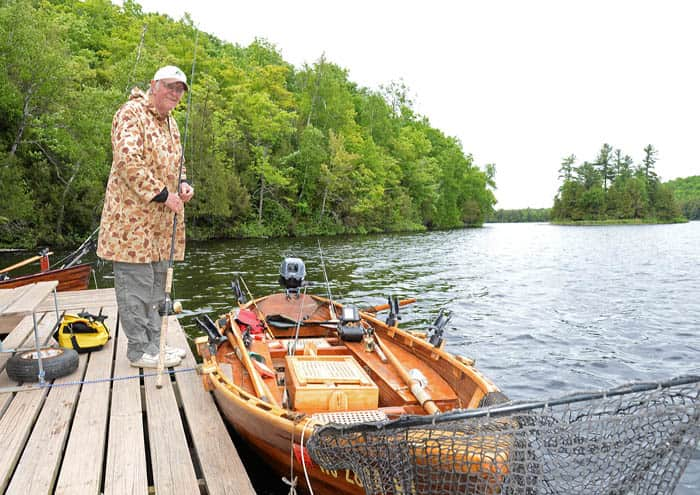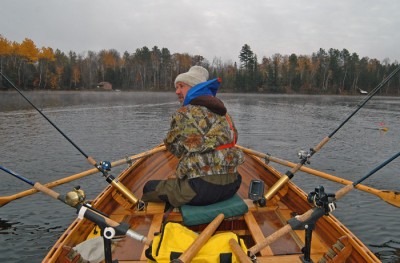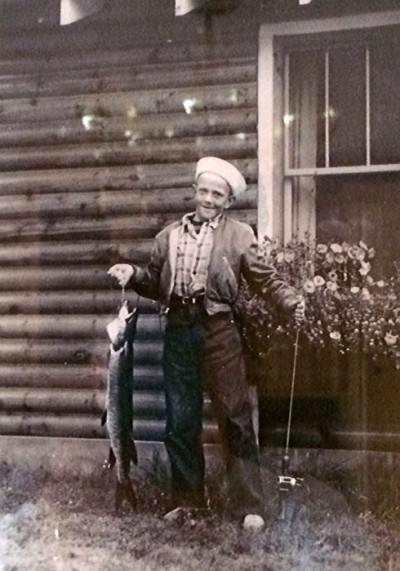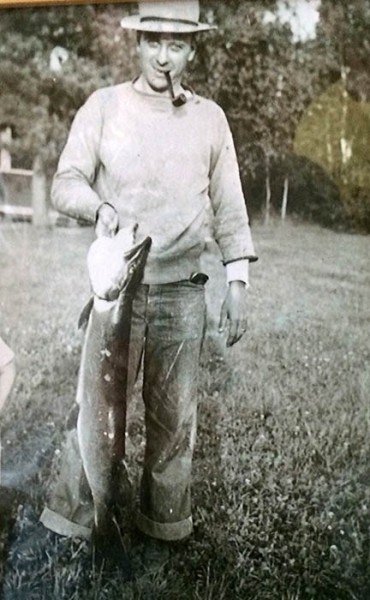Wisconsin Muskie Fisherman Tells His Tales Through Photos
Patrick Durkin 07.02.14

The one sure highlight of fishing in the Bob Ellis Classic row-trolling tournament each summer is hanging out at Jim Olson’s cabin on Crab Lake, Wisconsin when we’re not chasing muskies.
Lord knows we hear more fish stories while studying photos on Olson’s walls than we create ourselves behind the oars of my cedar-strip rowboat. I’ve fished the one-day Classic four times with former DNR Secretary Scott Hassett as my guide, and we’ve yet to get a strike, let alone land a muskie.

Hassett, of course, recounts his many previous muskies as we circle Crab Lake’s bays, traverse its trenches, and cross its bars. But I’m not inspired. I’ve heard all his fish stories; at least four times. A man simply can’t catch enough muskies in one lifetime to deliver fresh material to fill four seven-hour days. So, I politely listen and silently pray for strikes, and fight the urge to talk politics or religion.
By Hassett’s estimate, Olson’s walls hold more than 60 photos of muskies, most caught on Crab and all held by Olson, friends, and family. I’ve often admired the framed black-and-white print of Olson with his first muskie in 1949. The Madison attorney, now 75, is wearing a sailor’s cap high on his head, and grinning proudly while straining to hold the muskie’s tail above the grass.
“Dad should have been charged with child abuse for turning me into a muskie fisherman at age 10,” Olson said. “Catching that fish was really something. It took 17 years before I caught my next muskie, but I was hooked. I’ve never gotten it out of my blood.”
Actually, Olson’s father, Paul, didn’t rush his son into it. Olson remembers catching panfish with his dad from a Camp Wakanda pier on Madison’s Lake Mendota at age five, and later row-trolling the lake for everything but muskies the next few years.
“He would always tell me this was all great, but the only fish for him was the muskie,” Olson said. “He thought I was too young for muskies. He didn’t let me fish them ’til I was 10.”

Muskies might be the fish of 10,000 casts, but Olson caught his first the second time he chased them in Vilas County. “We were fishing Island Lake on the Manitowish Chain, and it was really windy,” Olson said. “Our anchor got caught and we couldn’t move, so we kept casting while waiting for someone to come help us. I had this heavy lure, and after 45 minutes I was so tired I could barely cast it. That’s how I caught my first muskie. I never tried casting for 45 minutes in one spot ever again.”
Another old black-and-white shows Paul Olson with a muskie in 1942. Jim was only three that year, so he can’t recall the day. But he knows the story. His dad was fishing the Chippewa Flowage in Sawyer County and caught the muskie on a South Bend Surf-Oreno lure.
“See those two holes high on its left side?” Olson asks. “Those are bullet holes. Dad kept a Colt .45 in his tackle box. They didn’t do catch-and-release back then. The lore is that muskies are so fierce that the only safe way to get them into the boat was to shoot them first. Another part of the lore is that some guys thought they killed the fish, but then it started flopping around inside the boat. They’d shoot it again and put bullet holes in their boat. Who knows if that ever really happened.”
I studied the photo, identified the bullet wounds, and asked an obvious question: “Why didn’t your dad shoot it in the head?”
“Well, he said it jumped just as he pulled the trigger,” Olson said. “I believed him until I was an MP [military policeman] in the Army. I couldn’t hit anything with a Colt .45. If I would have ever had to use it on anyone, I would have thrown it. Dad had the same genes I do, so I think he was just a bad shot.”
Even though Paul and Jim Olson row-trolled often for pike on Lake Mendota, they never thought to row-troll for muskies up north. In fact, he didn’t start row-trolling until the 1990s after reading about the legendary Bob Ellis, a local muskie fanatic who literally died row-trolling when struck by a boater who didn’t see him.
Olson first row-trolled with an old boat he refinished, but then built a boat of better design in 1997: a Cosine Wherry. He’s since built two more boats by himself, and helped friends with seven others, including mine.

Olson said he never tires of row-trolling on Crab Lake, and especially likes fishing after dinner.
“It’s nice to fish from a boat you’ve built,” he said. “Even when I’m tired after a long day, it’s nice to be rowing and fishing as the stars come out. I’ve learned a lot of the stars’ names, and for a long time I was thrilled because I saw the Northern Lights every night. But then I finally realized I was just seeing the lights from the Gogebic Correctional Institution. I guess some things are better left not knowing.”
Olson still row-trolls whenever he can, and strongly opposes a pending law to allow motor-trolling in Vilas County. His only concession to age is the 2.5-horsepower engine he bought this year for running back up the lake on windy days.
“Having that motor might be a mistake,” Olson said. “I’ve often said the best place to catch a muskie is going from here to there. You think you know the best places, but as soon as you start rowing from one spot to another, that’s when you’ll catch one.”
Meanwhile, Olson is doing what he can to “abuse” his grandkids by teaching them to fish muskies.
“I row for them and they row for me,” he said. “I’m not a great muskie fisherman, but a number of my grandkids have caught muskies, and their photos are on the wall.”
It’s tough to think of a higher honor.

